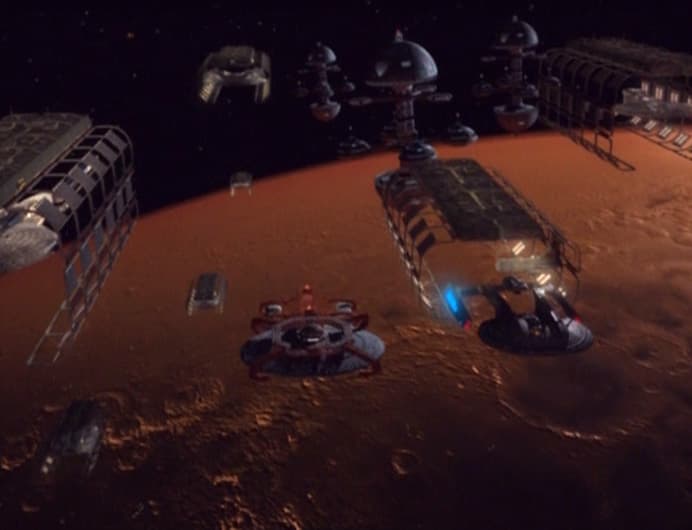HISTORICAL BACKGROUND
Recommended context for this chapter
Stardate 67431.7 - 2390 • 5 min read • INTREPID CLASS DEVELOPMENT

“The Federation stands as a testament to the power of diplomacy and progressive attitudes. We are currently witnessing the galactic golden era, with those that challenged those values having hidden back behind their borders with their tails between their legs. Never before has such a stable societal foundation been constructed, we live in a new time and with a new time comes new priorities. It is because of these priorities that I am advising that the planned construction of an additional 12 Ambassador Class ships should be canceled following the recent conclusion of the inquiry into the destruction of the U.S.S. Enterprise NCC - 1701 - C”
Authors Introduction
I struggled when writing this account of the efforts to bring Voyager home to know where to start. I found the answer was to simply look at what questions that the Federation was asking on the topic. How did a ‘long range explorer’ survive a journey alone across the Delta Quadrant? Why could the ship land? Why did a group of Maquis rebels fall in line behind a freshly promoted captain after she made the unilateral decision to stand them all 70,000 light years from home? How did Lieutenant Barclay know where to find Voyager, when it is now public knowledge that they managed to cut years of their predicted journey between that and the previous time the ship made contact?
To answer these questions and many more, you need to go back to the beginning. As far as I can tell the first inkling of what would become the Intrepid class was in the log you just read from Admiral Edward Janeway. I’m sure that some of my old colleagues in Starfleet R&D will be writing to me the moment that this is released to tell me why I’m wrong, or that I’m taking too many artistic liberties by tying such a vague statement to what would become a class of starship.
We know Edward Janeway worked in R&D, so it’s not unreasonable to believe that he would have had a greater part in pushing for the project to get off the ground than the average history book would be aware of.
However the internal machinations of Starfleet R&D aren’t as relevant as the wider socio-political context of the time in the shaping of what would become the Intrepid Class and why only 5 were ever made.
The modern Federation citizen would struggle to recognise the complacency and naivety of politicians less than 60 years ago. We now exist in a galaxy that feels as though it’s on a constant war footing and the worst part is, that’s not exactly an irrational feeling. In the past 40 years the Federation has faced existential attacks from the Borg, the Klingons, the Borg again, the Dominion, Shinzon of Remus, the Living Construct, the Zhat Vash, the synths of Coppelius and more.
It’s important however that we understand the galaxy in which the Intrepid class was conceived, as it’s only through that understanding that we can appreciate the complicated process of its development. The modern Starfleet officer would struggle to imagine the everyday technologies of the 2380s, let alone the 2360s. Marvels such as bio-neural gel packs, slipstream drives and astrometric sensors are commonplace on the modern starship, rather than being untested and often unreliable prototypes.
Starfleet was in a period of contraction, the Federation Presidency and wider political structures were, to use a crass term, ‘high on their own supply’. They believed that because they were all agreeing with each other, that the rest of the galaxy would agree with them. Especially after the Narendra III incident, which saw diplomatic ties with the Klingon Empire strengthen beyond what even they ever imagined possible. It’s rumoured and speculated that at one point the presidency was thinking of approaching the Klingons, to invite them to be the official defence force of the Federation, to allow Starfleet to solely focus on missions of exploration and science. Fortunately, given the events of 2372, this never came to pass. Or even reach the official proposal stage.
At the time it was believable that the Presidency might follow that path. It is through this believability that I hope you will be able to grasp the severity of the bitter ideological war that was occurring between the Starfleet Brass and the politicians. A war that Starfleet was losing. Starship and technological development projects were being underfunded, interfered with or just outright canceled constantly. Starfleet did what they could with what they had, but one need only look at the Niagara, New Orleans or Freedom class to see how much component recycling was going on to meet the arbitrary resource budgets that were being imposed without consideration for how this would impact the Federations defenses. If that’s not enough to convince you, just remember we were using 100 year old Miranda classes on the front lines in the Dominion War!
Please note that most of the interviews in this chapter come from the first Voyager inquiry.
INTREPID CLASS DEVELOPMENT